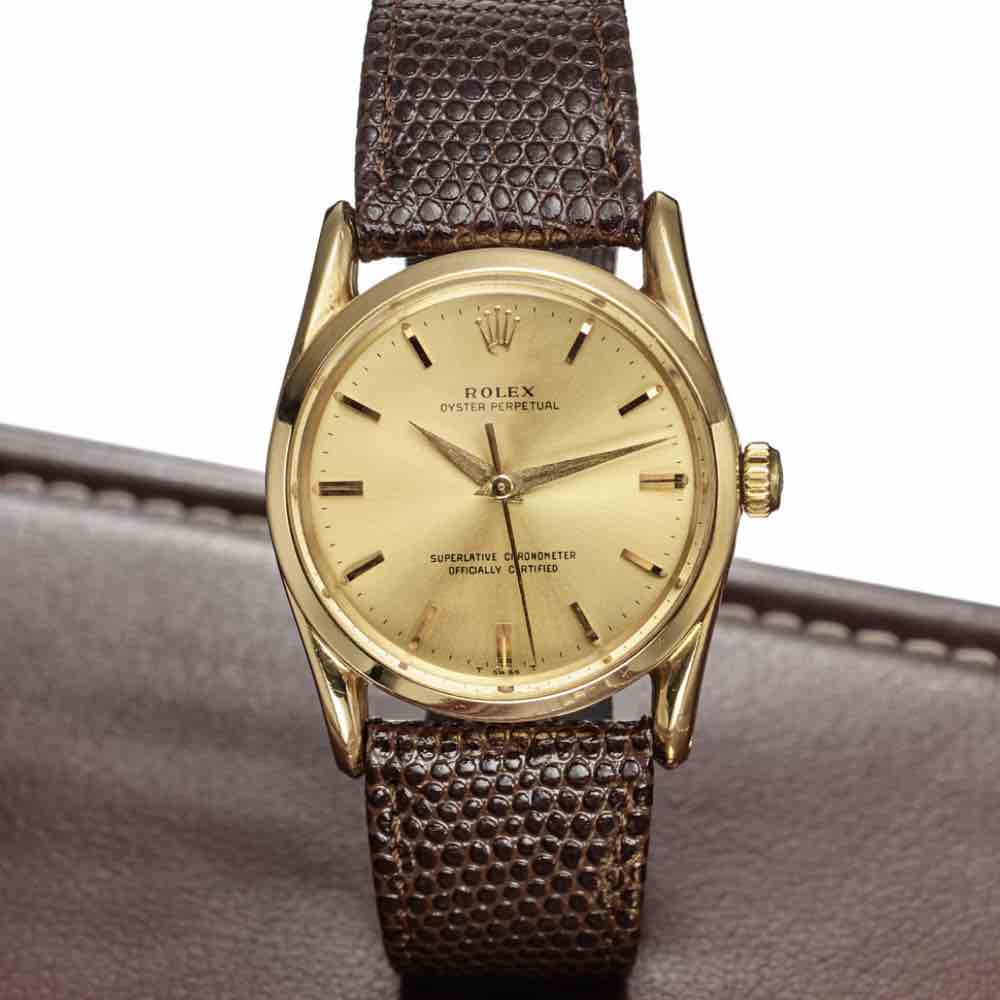Rolex introduced the original “Oyster” watch in 1926 circa, marking the world’s first waterproof timepiece.
This watch gained fame when Mercedes Gleitze wore it in 1927 during her English Channel swim. The watch remained functional after being submerged for over ten hours. This achievement marked a significant moment in Rolex history. While wristwatches water resistance is taken for granted today, a century ago, it was something truly unconventional.

Rolex founder Hans Wilsdorf celebrated this event in a newspaper advertisement, and Mercedes Gleitze became Rolex’s first brand ambassador, showcasing the watch’s durability and success.

However, achieving waterproofing alone wasn’t sufficient to transform the wristwatch into the indispensable item envisioned by Wildorf. Constantly unscrewing the crown to wind the watch’s mechanism posed a potential risk to the water resistance. In 1931, Rolex introduced the world’s first self-winding mechanism with a free rotor, known as the Perpetual rotor. This inventive system utilizes a weight to gradually wind the watch while it’s being worn on the wrist, giving rise to the name ‘Perpetual’ due to its ability to wind continuously. This innovation went far beyond just water resistance, changing completely the world of watchmaking.

The nomenclature ‘Oyster Perpetual’ first appeared in the horological world around 1945, signifying a pivotal moment in Rolex’s watchmaking history. This designation came into existence when Rolex seamlessly combined their innovative self-winding mechanism with the enduringly strong Oyster case design.

In the late 1940s, Rolex introduced a distinctive new Oyster Perpetual model characterized by its unique design features. Notably, the watch had lugs with a spiral-like pattern and a rounded profile. In Rolex’s advertising catalogs of that era, these timepieces were simply referred to as the Oyster Perpetual. Interestingly, among collectors and enthusiasts, these watches have come to be affectionately known as Rolex Bombay. It’s worth noting that Rolex has never officially used this term in any of its official publications. The origin of this nickname can be traced back to the term “bombè,” which was originally used to describe the curved shape of the lugs. Over time, this term evolved into the current nickname, which, while possibly not entirely accurate, has certainly become the most commonly used and recognized designation.

The Rolex Bombay, although it always maintained a case size of approximately 34mm, was produced in various versions and references over the years. Here, we’ll summarize the characteristics of the models known for their Bombè lugs:
- References 5016 and 5018: These are the first references with Bombè lugs in the history of the Oyster Perpetual. Both models are equipped with the 9 ¾” caliber, but the 5016 features subsidiary seconds at 6 o’clock, while the 5018 has central seconds.


- Reference 6090: In the early 1950s, the Rolex Bombay was fitted with the new A.260 caliber, and concurrently, the version with small seconds at 6 o’clock was phased out. The two variants were unified into a single model distinguished by central seconds.

- References 6590 and 6593: In the mid-1950s, the caliber 1030 was introduced, leading to another change in the reference for the Rolex Bombay. The 6590 featured a smooth bezel, while the 6593 had a fluted bezel. Both models featured central seconds.


- References 1010 and 1011: In 1959, when the movement 1030 was replaced by cal. 1560, the references also changed: 1010 for the model with a smooth bezel and 1011 for the version with a fluted bezel. These would be the last Bombay references to remain in production until the 1970s. They were later updated with the cal. 1570 but without a change in reference numbering, as had happened previously.


From a stylistic perspective, the Oyster Perpetual Bombay has undergone an evolution in line with changing tastes over the years. The earlier models are undeniably more eccentric, featuring gilt, enameled, textured, grené, and honeycomb dials with arrow-shaped, triangular, stylized indices, and hands that complement these styles. However, starting from the late 1960s, the preference shifted towards a more understated look, with rectangular indices and simple baton hands.
As a result, there exists a multitude of possible configurations for the Oyster Perpetual Bombay. The ones most sought after by collectors are undoubtedly those with unique and distinctive dial characteristics that express the creative refinement of those historical periods.

This Rolex Oyster Perpetual reference 6090 is undoubtedly one of the rarest and most captivating Bombay models ever produced. The dial features a two-tone design with an outer ring in rose gold and a black gilt lacquer center with sparkling gold OCC lettering, complemented by dauphine hands, creating a truly extraordinary aesthetic. Very few examples with this dial configuration have come to market because they were produced in very limited quantities, catering to the most discerning and extravagant clientele. The rarity of this 6090 is further accentuated by its rose gold case, a material seldom used in Bombay models. The icing on the cake is the rose gold mesh bracelet from the same production period as the watch. The preservation condition is truly exceptional: the case still boasts beautiful Bombè lugs with well-defined shapes, deep hallmarks, and perfectly visible serial numbers. The A.260 caliber functions flawlessly, the black gilt lacquer dial remains mirror-like without any defects, the case back shows no closure issues, and the Super Oyster crown works as it should. The bracelet is neither loose nor deteriorated.
This watch is exceptional, both for its rarity and its beauty—an object for a discerning collector seeking a truly unique timepiece.
Now, a series of photographs of this magnificent watch, which will soon be available in our e-shop.




















